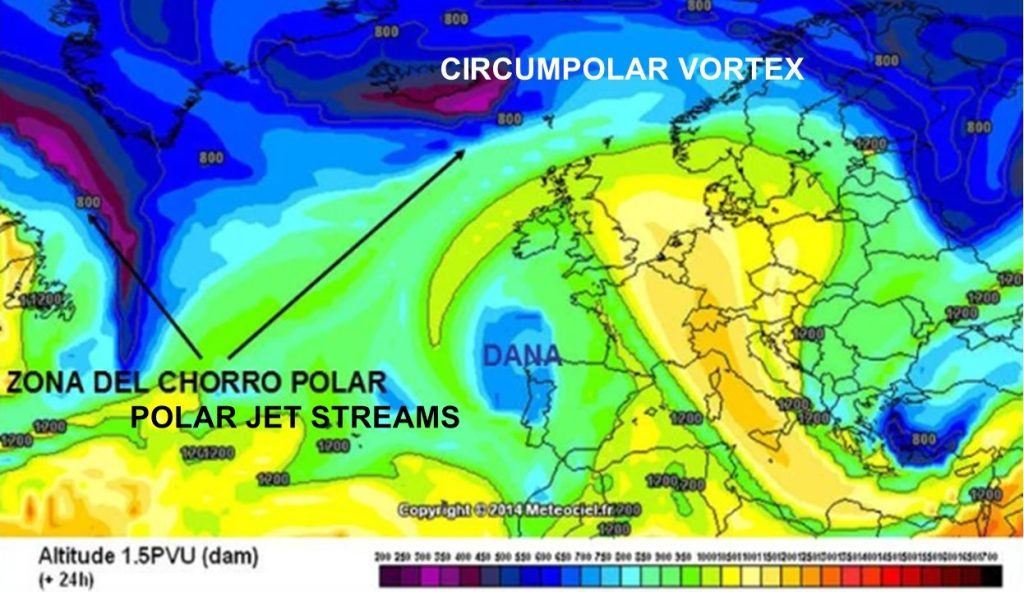DANAs and Climate Change
In the past decade, Spain has experienced more frequent extreme weather events called DANA, short for Depresión Aislada en Niveles Altos (Isolated High-Altitude Depression). This weather pattern occurs when cold air from the polar regions gets separated and mixes with warm air from the Mediterranean, creating powerful storms at high altitudes (Figure 1).

Figure 1. DANA cartographic representation.
Source: https://www.tiempo.com/ram/106552/como-identificar-una-dana-en-los-mapas-del-tiempo
Latest torrential rains episodes in Comunitat Valenciana
The latest data from AEMET on rainfall in Comunitat Valenciana, during September, 2024, indicate intense weather patterns (Figure 2). The province of Castellón has been particularly affected by the cold drop, with small town Borriol accumulating 185 litres per square metre (l/m²) so far. In both the provinces of Valencia and Castellón, rainfall has reached 20 l/m² per hour.
In the Comunitat Valenciana, DANA often triggers intense, localised heavy rainfall, thunderstorms, and flash floods, especially in late summer and autumn. Due to its geographical position and Mediterranean climate, the region is particularly vulnerable to DANA’s effects, which can cause significant damage to infrastructure, agriculture, and local communities.

Figure 2. Map of DANA in Comunitat Valenciana (September, 2024)
Source: AVAMET (2024)
Torrential rain episodes in the history of Spain’s climate
Spain has experienced several devastating DANA weather events. Each of these episodes led to severe flooding and long-lasting impacts on affected communities.
1. Valencia Flood (Spanish: La gran riada de Valencia) (October, 1957)
A major flood hit Valencia when over 400 litres per square meter of rain fell. The Turia River, carrying up to 4.400 cubic meters per second, overflowed, devastating the city and causing over 100 deaths. This disaster led to significant changes in Valencia’s urban planning, including diverting the river to prevent future floods (Figure 3).

Figure 3. The Campanar Bridge flooded by the Turia River (October, 1957).
2. Southeast Spain Catastrophe (October 1973)
Torrential rains in Granada caused over 600 litres per square meter in just a few hours, devastating towns and killing over 500 people.
3. Tous Flood (October 1982)
Heavy rains caused the Tous Dam in Valencia to fail, with river flows reaching 16.000 cubic meters per second, leading to widespread flooding.
4. DANA of September 2019
In Alicante, Valencia, and Murcia, over 500 litres per square meter of rain submerged areas for weeks, causing significant damage.
Rising Urgency: Adapting to a Changing Climate
The unpredictable nature of climate change makes it difficult to forecast the future evolution of extreme weather in the Mediterranean. The recent rainfall data from Spain reflects the complex and uneven effects of climate change on weather patterns. The increase in the frequency and intensity of storms like DANA, underscores the urgent need to adapt to and mitigate the effects of a changing climate, as these trends are likely to continue and intensify in the coming years.
Experts warn that urgent efforts must be made to adapt to climate change and its atmospheric consequences. Without these efforts, Spain will continue to face devastating storms, floods, and heatwaves that disrupt lives, economies, and ecosystems.
According to experts, the country’s current infrastructure is ill-prepared for these weather extremes. Cities are not equipped to handle extreme temperatures or torrential rains, and drainage systems must be upgraded to accommodate the increasingly intense rainfall. Urgent action is required at both regional and local levels. Sewer systems must be expanded, land-use planning improved, and civil protection mechanisms enhanced to mitigate the effects of future DANAs.
Spain has already established the National Plan for Adaptation to Climate Change (PNACC), aimed at coordinating actions to tackle climate change until 2030. However, implementing these measures effectively will require cooperation across all levels of government.

